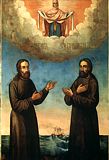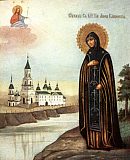

| Previous day | Next day |
| Old Style
June 12
|
Monday |
New Style
June 25
|
|
5th Week after Pentecost.
Tone 3.
Fast of the Holy Apostles. |
Monastic rule: xerophagy (bread, uncooked fruits and vegetables).
|
![]() St. Onuphrius the Great (4th c.).
St. Onuphrius the Great (4th c.). ![]() St. Peter of Mt. Athos (734).
St. Peter of Mt. Athos (734).
Sts. John, Andrew, Heraclemon, and Theophilus, hermits, of Egypt (4th c.). St. Arsenius, founder of Konevits Monastery (1447). St. Onuphrius, founder of Malsk Monastery (Pskov) (1492). Sts. Onuphrius and Auxentius, monks, of Vologda (15th c.-16th c). St. Stephen of Komel, founder of Ozersk Monastery (Vologda) (1542). Sts. Jonah and Bassian, monks, of Pertoma (Solovki) (1561). First (1650) and second (1909) glorifications of St. Anna, princess of Kashin (Euphrosyne in monasticism). St. Onuphrius, founder of Katrom Monastery (Vologda) (16th c). Uncovering of the relics of St. John of Moscow, fool-for-Christ (1672).
Miracle-working icons of the Theotokos and St. Onuphrius at St. Onuphrius Monastery (Poland).
St. Amphianus, bishop and confessor, in Cilicia (ca. 310). St. Olympius, bishop and confessor, in Thrace (4th c.). St. Timothy the Hermit, of Egypt (4th c.). Virgin-martyr Cunera of Rhenen (Neth.) (451). St. Julian of the Dagouta Church in Constantinople. St. John the Soldier, of Egypt (6th c.-7th c.). St. John (Tornicus) of Mt. Athos and Georgia (998). Synaxis of the Saints of St. Onuphrius Monastery at Jablechna (Poland). St. Triphyllius, bishop of Leucosia [Nicosia] on Cyprus (370).
Repose of Elder Peter of Katounakia, Mt. Athos (1867), and Blessed Hermit Philaretus of Mt. Athos (1961).
Thoughts for Each Day of the Year
According to the Daily Church Readings from the Word of God
By St. Theophan the Recluse

Monday. [Rom. 12:4-5, 15-21; Matt. 12:9-13]
It is lawful to do well on the sabbath days. This is what the said Lord after healing a man with a withered hand in the synagogue on the Sabbath day as a reproach to the Pharisees, who took the commandment about the Sabbath rest so far that they even measured the number of steps they could make on that day. But since it is not possible to do good deeds without movement, they would sooner agree to neglect good deeds than to allow any extra movement. The Saviour denounced them for this time and again, because the Sabbath required rest from worldly cares and not from deeds of piety and brotherly love. In Christianity instead of the Sabbath day, Sunday is celebrated with the same goal—rest from all worldly affairs and devotion of that day solely to deeds of God. Christian good sense never reached the pharisaic pettiness concerning not doing things on Sunday; but nevertheless the permissible allowance for doing things on this day has been set far beyond the proper limits. Not doing things alienated the Pharisees from doing good deeds, whereas the things which Christians allow themselves are what lead them away from good deeds. On the evening before Sunday they go to the theatre, then some other entertainment as well. In the morning they oversleep and there is no time to go to church. There are several visits, lunch, and in the evening again entertainment. Thus all time is relegated to the belly and pleasing the other senses, there is no time to even remember God and good deeds.
Articles
 Venerable John the Hermit of EgyptSaint John the Hermit lived in Egypt in the fourth century, and is mentioned in the Life of Saint Onuphrius. |
 Venerable Andrew the Hermit of EgyptSaint Andrew lived in Egypt in the fourth century, and is mentioned in the Life of Saint Onuphrius. |
 Venerable Heraclemon the Hermit of EgyptSaint Heraclemon lived in Egypt in the fourth century, and is mentioned in the Life of Saint Onuphrius. |
 Venerable Theophilus the Hermit of EgyptSaint Theophilus lived in Egypt in the fourth century, and is mentioned in the Life of Saint Onuphrius. |









